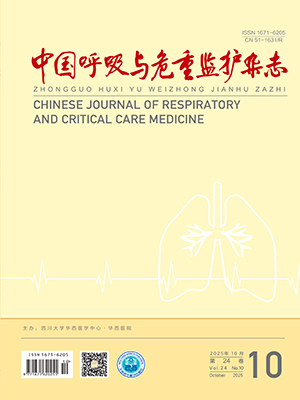Objective To establish a rabbit model of ventilator-induced lung injury. Methods Fourty healthy New Zealand rabbits were randomly divided into 3 groups: ie. a routine 8 mL/kg tidal volume group( VT8 group) , 25 mL/kg large tidal volume group( VT25 group) , and 40 mL/kg large tidal volume group( VT40 group) . VT25 and VT40 group were further divided into 2 hours and 4 hours ventilation subgroups. Arterial blood gas, lung mechanical force and hemodynamic parameters were monitored. Lung
tissue was sampled for evaluate lung wet/dry ratio and lung injury by HE stain. Bronchoalveolar lavage fluid ( BALF) was collected for measurement of protein concentration, total and differential cell counts. Results Compared with VT8 group, lung injury score in both VT40 and VT25 groups were elevated significantly, of
which 4 hour VT40 subgroup was the highest. Lung pathology examination of VT40 group revealed apparent alveolar deformation, interstitial and alveolar space exudation, inflammatory cells infiltration, pulmonary consolidation and alveolar hemorrhage. Lung pathology examination of VT25 group showed pulmonary interval
thickening, inflammatory cells infiltration, while alveolar intravasation was mild. Blood gas analysis showed that PaO2 /FiO2 was deteriorated with time in VT25 and VT40 groups, and PaO2 /FiO2 at the 3 hours in VT40 group( lt; 300 mm Hg) had met the acute lung injury standard, while which in VVT25 group was above 300 mmHg. Lung wet/dry ratio, BALF protein concentration, total nucleated cell and neutrophilic leukocyte were elevated in both VT25 and VT40 groups, of which 4 hours VT40 group was the highest. Conclusion Using 4 hours ventilation at a tidal volume of 40 mL/kg can successfully establish the rabbit model of ventilator-induced lung injury.
Citation: AN Li,ZHOU Meiling,QIN Xuebing,LIU Qinghui,LIU Changting,YU Senyang. Establishment and Evaluation of Rabbit Model of Ventilator-Induced Lung Injury. Chinese Journal of Respiratory and Critical Care Medicine, 2010, 9(2): 163-167. doi: Copy
Copyright © the editorial department of Chinese Journal of Respiratory and Critical Care Medicine of West China Medical Publisher. All rights reserved




